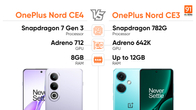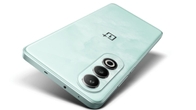Review Summary
Expert Rating
The days of OnePlus smartphones being budget flagships are long gone and it is kind of understandable why. As more powerful chipsets, advanced cameras, new features, more RAM, and faster storage pile up, it is only natural for the price of phones to rise over the years. This holds true for a company like OnePlus as well, which has built a reputation for being a “flagship killer”. That title is holding less and less weight in the western markets where the OnePlus 8 Pro’s price tag is close to breaching the $1,000 mark, but is still cheaper than the likes of Galaxy S20s and iPhone 11 Pros (review). In India, however, OnePlus has priced its goods at significantly lower prices which makes its feature-rich smartphones compelling options.

We have already covered the OnePlus 8 Pro in great detail and you can read the review here. That leaves us with the OnePlus 8 which is more in line with the company’s philosophy of an affordable flagship than its Pro moniker. At a starting price of Rs 41,999, the OnePlus 8 is still taking a significant chunk from your wallet, which begs the question as to what sets the OnePlus 8 apart from the horde of budget flagships crowding the market? In this detailed review, we are going to answer that very question.
Verdict
If it’s a bang for your buck that you want, then the OnePlus 8 is probably not the best of choices. While the phone checkmarks nearly everything you could typically want from an affordable flagship, shortfalls in the camera department and not being able to provide as much value-for-money as the competition, are causes for concern. As was the case last year with the OnePlus 7 series, once again it is the Pro version that has hogged all the limelight while the regular OnePlus 8 has been left in the shadows.
Design and display
- Display: 6.5-inch FHD+ AMOLED
- Refresh rate: 90Hz
- Protection: Gorilla Glass 5
- Connectivity: USB Type-C
OnePlus has been making visually-appealing devices and I have to give full props to the company for following it up on the OnePlus 8. While several OEMs include dual-tone gradient finishes or some prism-reflecting pattern on the back to make their smartphones look like eye candies, OnePlus has kept it simple and classy. The variant we have received has just the single shade of black on a shiny surface which is protected by Corning Gorilla Glass 5, making it both scratch-resistant and extremely slippery. Inside the box, you will find a clear silicone case which will be quite handy in case (pun intended) the phone falls and also to avoid any wobble on a flat surface caused by the protruding camera module.

As compared to the OnePlus 7T (review), the OnePlus 8 weighs slightly less while the width has also been reduced a bit to give an easier grip. The triple camera on the back is reminiscent of the OnePlus 7 Pro (review) and is arranged in the exact same vertical housing at the top-center. The signature OnePlus alert slider is present on the right side along with a textured power button. The volume rocker keys are present on the left side while the bottom of the device has the Type-C port, dual-SIM port, and a speaker. Unlike the Pro version, the OnePlus 8 does not have an official IP rating but it is been advertised as splash-proof.
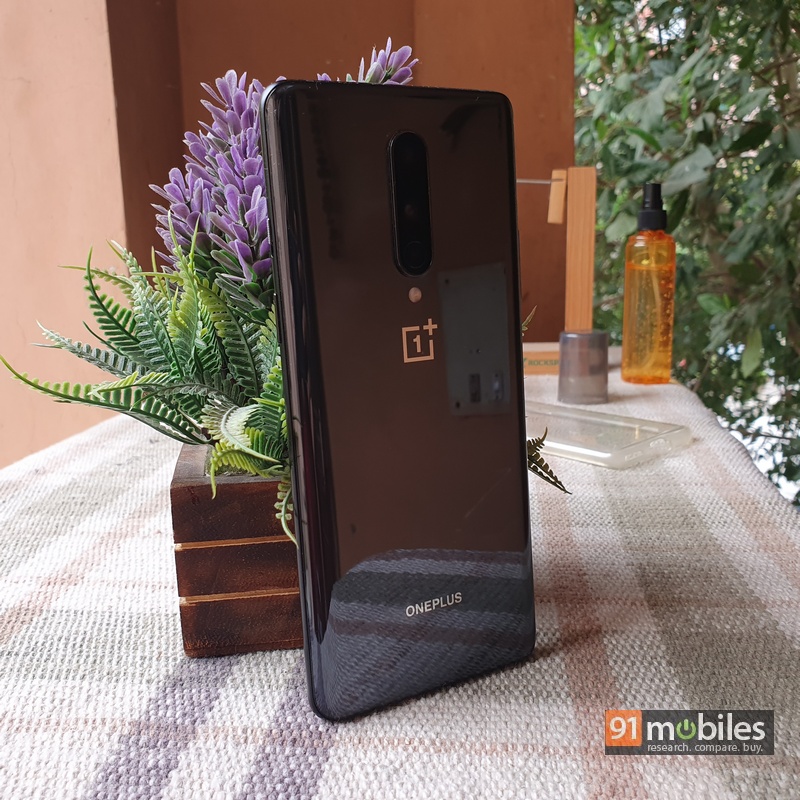
Since the OnePlus 7 Pro, the company has said that all its phones will be featuring higher refresh rate panels (at least 90Hz), and so far the company is holding true to its word. On that front, the OnePlus 8 gets a stunning 6.5-inch Super AMOLED panel with FHD+ (2,400 x 1,080) resolution, 20:9 aspect ratio, and a 90Hz compliant screen. Unlike the OnePlus 7 (review) or the 7T, the OnePlus 8’s display curves slightly on both sides which serves aesthetic value but nothing in terms of actual usage. OnePlus has also ditched a notch or a pop-up mechanism of any sort and opted in for a much more modern looking hole-punch design which is present on the top left. The size of this cut-out is minuscule and fades into the background when watching any content for an extended period of time.
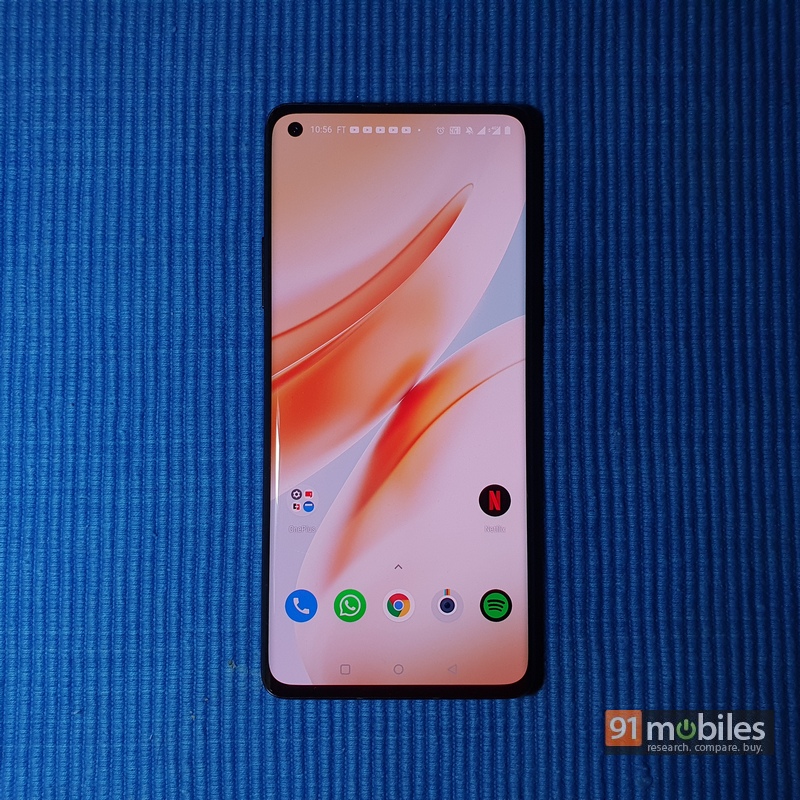
The display itself is top quality as I have come to expect from OnePlus. Extreme vibrance and crispness in colours along with excellent luminosity make the phone a true media consumption device. Pronounced blacks and superb viewing angles owing to the AMOLED nature of the screen just increases the viewing pleasure. There are several customisations available in the display settings such as screen calibration options which help you adjust the colour temperature and tones. There are three options which are Vivid, Natural, and Advanced and as a personal preference, I would recommend Vivid for punchier colours. There is a Night Mode which filters harmful blue light at night, but if you are looking for a system-wide dark mode it can be found in the Theme customisation menu. Reading mode will turn your display into monochrome making it easier to read while a separate mode called the Vibrant color effect does exactly as advertised. Lastly, the refresh rate on the device is a fluid 90Hz which can be turned down to 60Hz for lower battery consumption.
Cameras
- Rear cameras: 48MP main, 12MP ultra-wide and 2MP macro
- Front camera: 16MP
While the OnePlus 8 Pro’s camera has catapulted to a true flagship level, the same attention has not been provided to its sibling. In fact, looking at the camera specs I feel that OnePlus has downgraded the camera module from last year’s OnePlus 7T. The primary camera on the OnePlus 8 is the same 48MP Sony IMX586 sensor that is seen on the 7T and also on the 7 Pro. The secondary sensor is an ultra-wide lens of 16MP resolution which is the same as the 7T but lacks auto-focus capabilities. The third camera is a macro sensor of 2MP resolution. The OnePlus 7T had a more useful 12MP telephoto sensor with 2X optical zoom as a tertiary camera. Apart from that the ultra-wide sensor on the 7T was capable of clicking macro shots as well.

When the OnePlus 8’s primary camera has a ton of light thrown at it, we can definitely see excellent photos with great dynamic range, exposure correctly calibrated, and a tinge of over-saturation. The device does have great autofocus capabilities although it is only a feature of the primary sensor. There is OIS on the main camera, so the chances of getting a blurry shot while moving are reduced considerably.

The wide-angle lens has the same 120-degree field of view as the OnePlus 7T but images produced from the sensor are dull and slightly less contrasty than from the main sensor. Since there is no autofocus, you have to tap to focus on the subject. The phone offers 10X digital zoom which is not very useful when the light dips. The 2MP macro camera sub-par and if you were to ask me, shouldn’t be there on a flagship phone. I think the company should have integrated the macro capabilities on the ultra-wide lens like the OnePlus 7T.
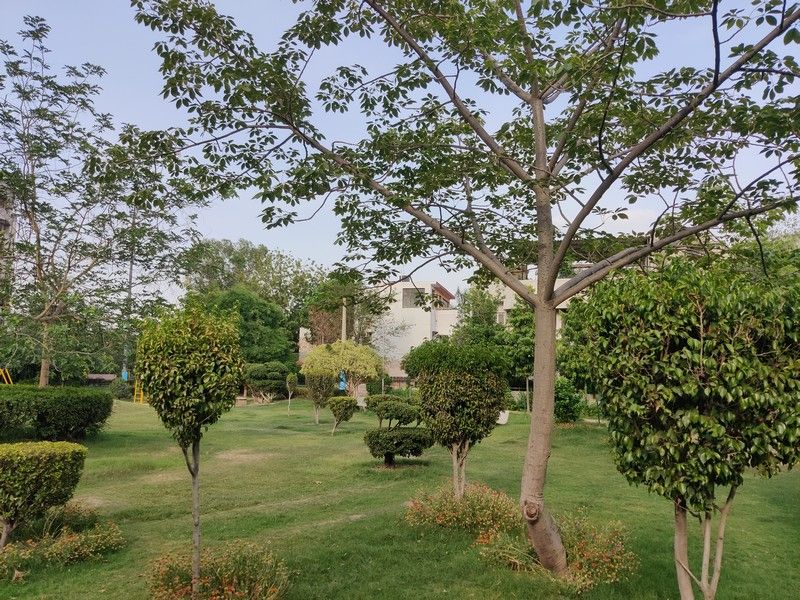
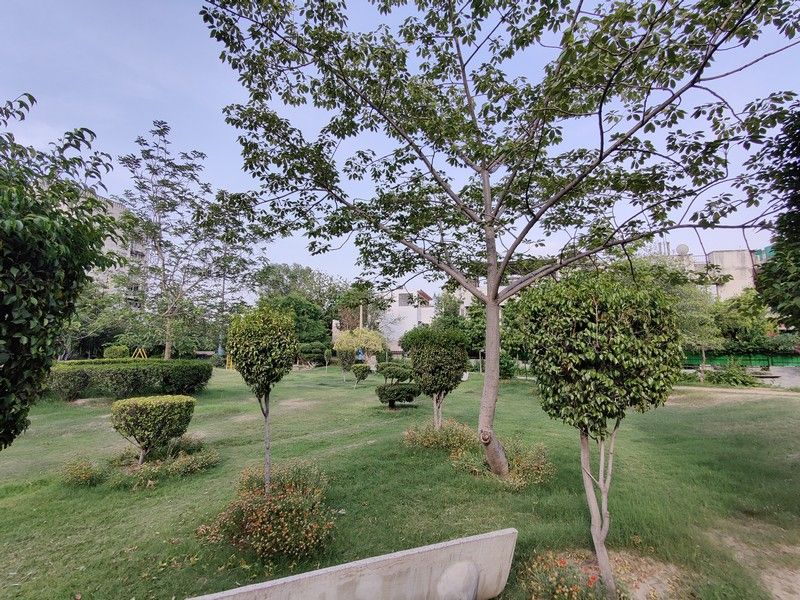
Low-light photography also isn’t the OnePlus 8’s strong suit, although to be fair its Pro sibling struggles slightly at night time as well. In general, focusing on the subject seems to be the major drawback of the primary sensor. External sources of light such as street lamps help the phone in capturing details but you can hardly use the ultra-wide sensor even in those situations. When the lighting is extremely dim, the primary sensor automatically adds light to shots and along with it comes an unhealthy amount of noise. There is a Nightscape mode for assisting in low-lighting situations but most of the time the difference is negligible when compared to normal shots. However, the ultra-wide does see a big boost with Nightscape on as opposed to clicking shots without it. As usual, the macro sensor, like almost every other phone, doesn’t work well in low light.
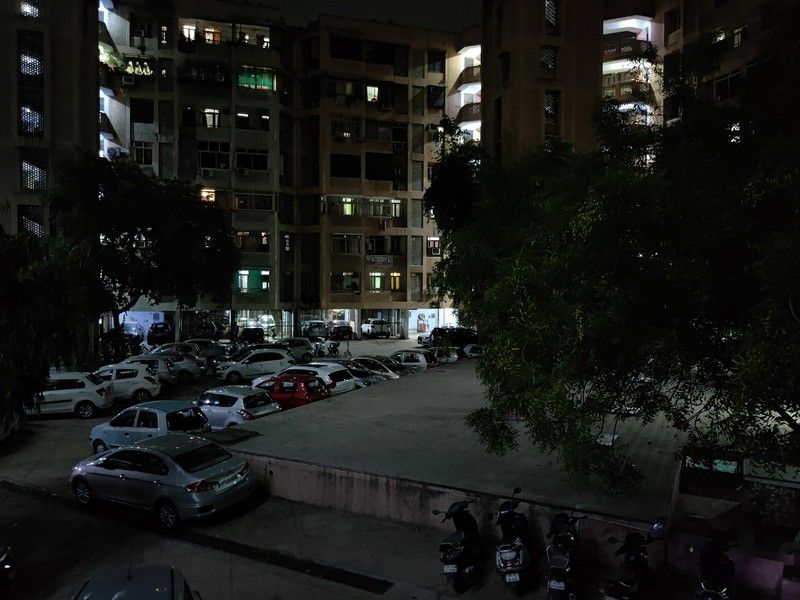
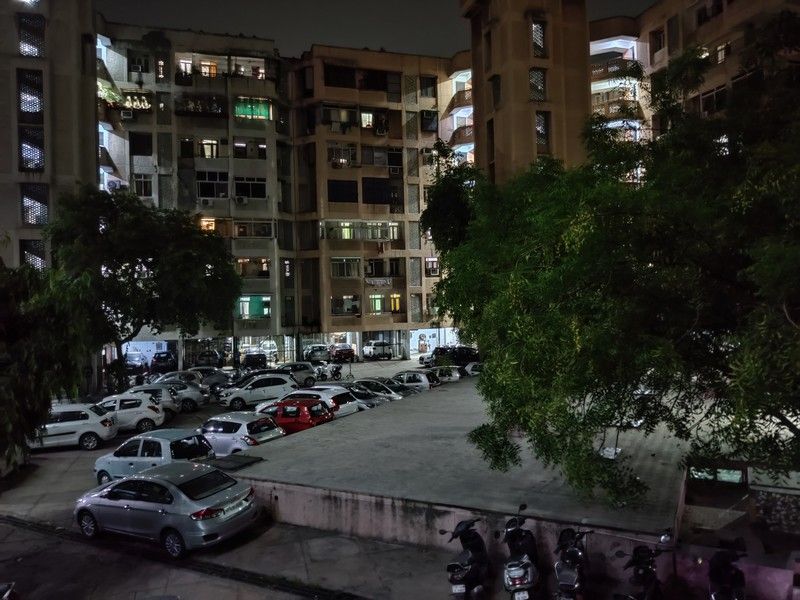
Lest we forget, the OnePlus 8 can also produce portrait shots for a pleasant bokeh effect. While it would work even better with a depth or telephoto sensor, the AI-generated portrait shots were quite colour rich, had a good focus on the subject and produced a nice soft blur which is easy on the eyes.
On the front, we have the same 16MP sensor that was seen on the OnePlus 7T and for the most part, selfies taken are great. The skin tone, facial features and the focus, in general, are at par from what you can expect from a premium phone. Low-light performance, however, can be considered slightly iffy. In terms of video, you can get a maximum of 4K recording at 60fps while 1080p can be pumped up to 240fps and 720p videos can be shot at 480fps.
Software and performance
- Chipset: Snapdragon 865
- RAM: 6GB, 8GB and 12GB
- Storage: 128GB and 256GB
- Software: Android 10 with OxygenOS
When we talk about OnePlus phones, one area where there is little doubt of imperfection, is definitely performance. OnePlus has been known not to cut corners as far processing prowess is concerned and it is more of the same on the OnePlus 8. You cannot go wrong with the Qualcomm Snapdragon 865 SoC which delivers blazing-fast performance along with excellent power efficiency. As a matter of fact, if benchmarks deliver a quantitative value on a device’s performance then OnePlus 8’s single-core and multi-core scores of 918 and 3379 respectively beat even the 8 Pro and the Galaxy S20 Plus. On the GFXBench the phone had 3,735 frames for the Manhattan test and 3,373 frames for the T-Rex test while on AnTuTu we get a score of 579,239.

It’s pretty easy to paint a picture of the device’s performance after this. Apps run buttery smooth, app switching is instantaneous, running heavy-duty apps doesn’t break a sweat and in general, the 90Hz screen makes everything more fluid. There are three RAM options which are 6GB, 8GB and 12GB. I have received the high-end 12GB variant although I would recommend that if you plan on buying the device, the 8GB version is going to be quite sufficient and cheaper by Rs 5,000.

OnePlus phones have also been extremely proficient for mobile gaming and the OnePlus 8 is not going to disappoint. It goes without saying that PUBG Mobile and Call of Duty: Mobile both run at full graphics settings. I played for nearly 2 hours without any signs of overheating or frame drops. For even better performance, the phone has Fnatic Mode which frees up more RAM and boosts the graphical capabilities of the Adreno 650 GPU. In short, gamers are not going to have any problems with the device. On a side note, the phone supports 5G but I guess you will have to wait for a while before actually using the capability in India.

Authentication-wise, the phone has an in-display fingerprint sensor which is positioned slightly higher up on the screen than I would’ve liked. However, it is still one of the fastest sensors in the market with the device unlocking at lightning speeds. The face authentication, while less secure than the fingerprint sensor, again leads the industry standards. There is no headphone jack, which was expected, but the stereo speaker setup makes up for it easily.

On the software side of things, the OnePlus 8, like its sibling runs on the custom OxygenOS skin which is based on Android 10. You can read about it in our OnePlus 8 Pro review, but here is a short summary: arguably the best software experience on Android, nearly zero bloatware, clean and concise to user needs, minimalistic and blazing fast.
Battery
- Battery: 4,300mAh
- Charging: 30W Warp Charge 30T
Some of the previous generation OnePlus devices were not exactly battery-efficient but that has changed over time. The OnePlus 8 gets a smaller 4,300mAh battery than what the OnePlus 8 Pro offers, but also keep in mind that the former’s screen has a lower resolution and lower refresh rate. I kept my screen at 90Hz for the duration of my review period, and I have to say that I’m very impressed. During my intensive usage of the device, which involved a lot of content watching on Netflix, social media browsing, YouTube and PUBG Mobile, I was easily able to last the whole day without any concerns for the battery. An hour of gaming dropped the battery by 25 percent, which is very impressive since I was playing at maximum graphics settings. Without gaming, you are looking at a screen on time of roughly 6 hours.

As far as charging goes, the phone happens to have the Warp Charge 30T technology which can juice up the device from 0-100 percent in 50 minutes flat. There is, however, no wireless charging feature that the 8 Pro has. Even so, a 15-minute charge can boost up the battery to nearly 50 percent which is always nice to see.
Final Verdict
The reason why OnePlus 8 has received extra criticism in the Western markets was due to the device’s high pricing. In the US, the OnePlus 8 is being sold for a starting price of $699 which translated to nearly Rs 52,000, a steep increase in price from last year’s OnePlus 7T. Fortunately in India, the OnePlus 8 starts at Rs 41,999 for the 6GB RAM + 128GB storage version. However, unlike the US, in India, there are many OEMs encroaching on the affordable flagship territory and at lower prices too.

The OnePlus 7T is actually still available for purchase for a significantly lower starting price point of Rs 34,999. This phone offers a capable Snapdragon 855+ SoC, a better triple-camera setup, the same 90Hz AMOLED panel, the same software experience, and the same front-facing stereo speakers. A minute drawback is the dated waterdrop-notch design but that should be of little concern since the display remains top-notch. It doesn’t offer 5G, but for the foreseeable future, there is no use for it in the Indian market. So this means that the OnePlus 8 is just an incremental performance upgrade. In fact, there is probably no point in spending Rs 49,999 for the top-end 12GB + 256GB variant when you can get a full-fledged flagship experience in the 8 Pro by spending Rs 5,000 extra.

The IQOO 3 5G (review) comes to mind, a phone which offers 12GB RAM and 256GB storage at Rs 44,990 (a full Rs 5,000 lower than the OnePlus 8 variant with the same configuration). Realme’s X50 Pro (review), while priced exactly the same as OnePlus 8, has a quad-camera setup, 65W charging and dual selfie cameras, while keeping nearly all the features seen on the OnePlus 8. The one advantage that OnePlus 8 has over the other two devices is its impeccable software experience, which might not be enough to sway customers, but shouldn’t be ignored at all. The software platform is a critical part of the overall usage experience I feel, and that, combined with its top-end hardware, do make the OnePlus 8 worth a second look.
Editor’s rating: 3.5 / 5
Pros
- Vibrant and punchy 90Hz display
- Excellent performance and thermal management
- Great battery life
- Best-in-class Android experience
Cons
- Night photography is iffy
- Macro camera is below par
- Pricing could have been better






























![[Update] OnePlus mistakenly announces Google Gemini Ultra AI coming to its phones later this year Thumbnail](https://www.91-cdn.com/hub/wp-content/uploads/2024/04/OnePlus-AI.jpg?tr=h-110,q-100,pr-true)



